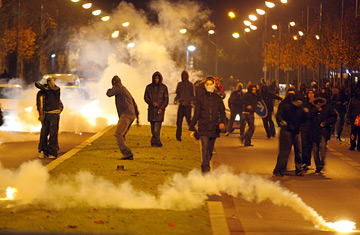
For the second night running, rampaging youths of Villiers-le-Bel, northern Paris suburb, throw Molotov cocktails and set fire to cars.
Fears of renewed nationwide rioting that rocked France two years ago grew Monday evening, when youths from a suburban Paris housing project staged a second straight night of battles with police. A total of 77 injuries (five serious) among officers have been reported since the rioting began Sunday afternoon, when two teenage residents of Villiers-le-Bel died after their motorcycle collided with a police car. But with the initial attacks on Sunday night having spread to five outlying suburbs during clashes Monday, concern is now rising that rioting may wind up spreading across the nation as it did in 2005 if it manages to ignite resentment bottled up in other French projects.
Over 100 youths from the suburb of Villiers-le-Bel 12 miles north of Paris pelted riot police with projectiles for around six hours Monday night; police responded firing back tear gas and flashballs at assailants. Rioters also torched dozens of cars, several businesses, police posts and municipal buildings, and used their intimate knowledge of the labyrinth of project buildings to maneuver security forces into exposed areas. Despite a call for calm by families of the deceased, local youths continued their arson attacks and clashes Monday to protest what they say is police responsibility for the deaths.
French government officials have expressed sympathy to the families of the youths killed in the accident; meanwhile, police officials are pushing ahead with an investigation into the crash to verify whether the teens were responsible as evidence suggests. Thus far, however, that has not placated young project residents who say they are fed up with the routine police harassment, racism, unemployment and general social stigmatization they receive in the suburbs, known as "banlieues." The spread of nocturnal rioting to outlying towns Monday night, meanwhile, seems to indicate the rage unleashed in 2005 rioting is still very much intact today.
"The basic problems are unchanged: people in the projects don't have the same educational and economic opportunities others do, and they feel like they're being shut away in their dismal neighborhoods because the rest of the country doesn't want them," says Raphaël Cazenave, a resident of the northern Paris suburb of Bondy who works with schoolchildren from the area. "The way these youths are expressing their anger and disgust is entirely destructive and stupid. Yet they'll keep doing it just as they have since 2005, because nothing has changed since."
Indeed, despite the headlines the violence in Villiers-le-Bel has generated, periodic clashes with police and bouts of vandalism in reaction to perceived injustices are routine events in France's banlieues. University of Grenoble Sociology and security professor Sebastian Roché estimates around 100 cars are burned across France on an average night, and limited battles with police common. But what makes events in Villiers-le-Bel different — and potentially contagious to other blighted areas across France — is the passion they've generated. Roché says levels of frustration felt in banlieues usually produce an equally powerful reaction to provocation — in this case the death of innocents that mobilized scores of enraged youths into street assemblies. Added to that Roché adds, is an intensity of combat with police that is also frequently a factor in violence spreading from one area to others with no connection to initial events.
"The extent of physical interaction between police and youths is a significant variable, because it creates passion and outrage among kids elsewhere who have trouble with cops on their own turf. In this instance, we've seen a lot of throwing and firing back and forth," Roché notes. "Injuries are another measure. So far, we've had 77 police injuries in just two nights of conflict alone, versus 200 police injuries in three weeks of rioting in 2005. This is pretty intense."
However, Roché says efforts made by authorities to express remorse over the victims of the accident that set off the rioting — and refrain from denying any responsibility of police in their deaths — marks a major difference with 2005. Back then, it was largely the refusal by authorities to even consider that the police had played a role in the deaths of two young residents of Clichy-sous-Bois that whipped their peers into rioting that soon spread across the nation. "It's that attitude that banlieue residents deserve whatever they get that makes so many people angry," notes Cazenave. "It still makes them angry — and it should."
